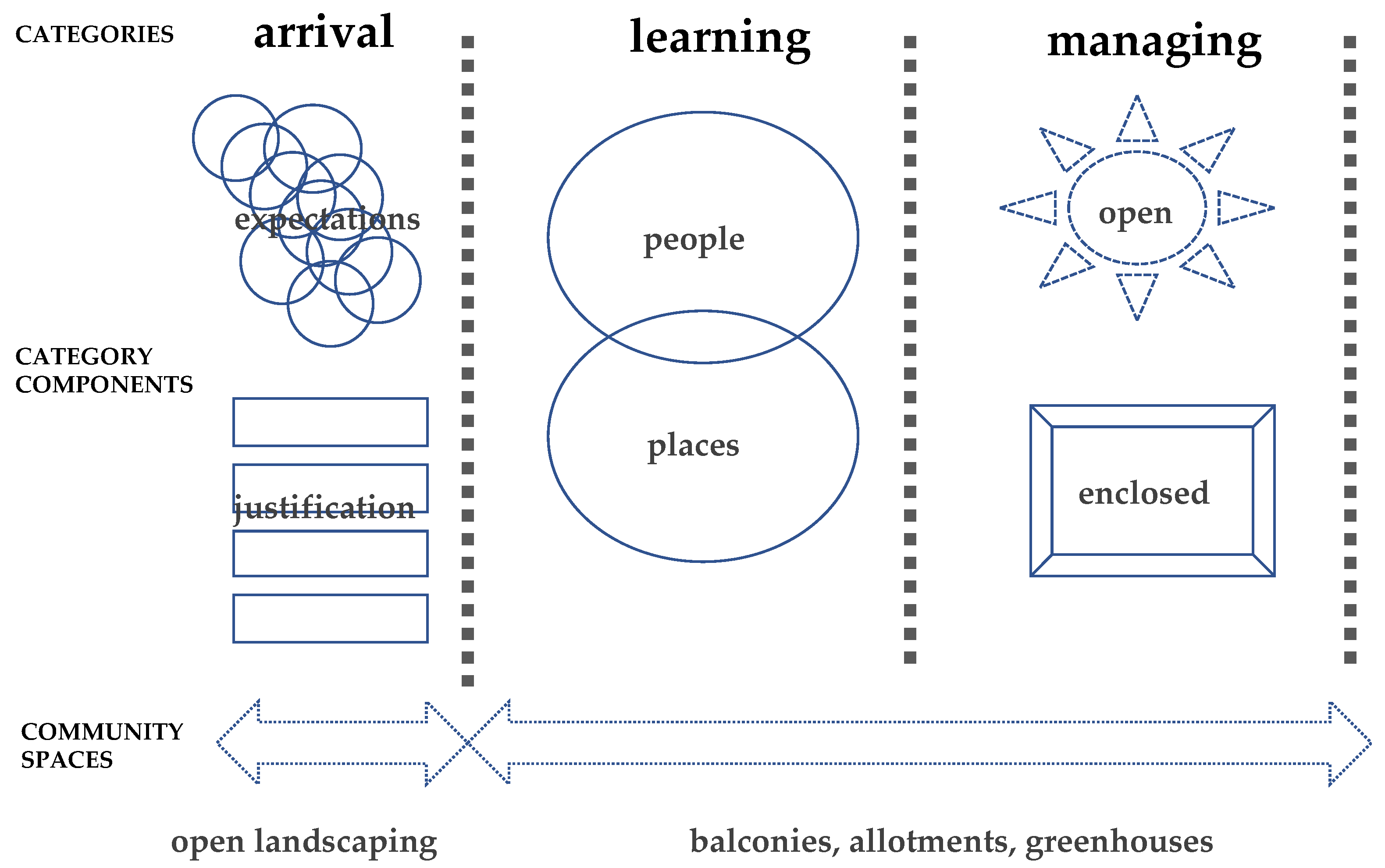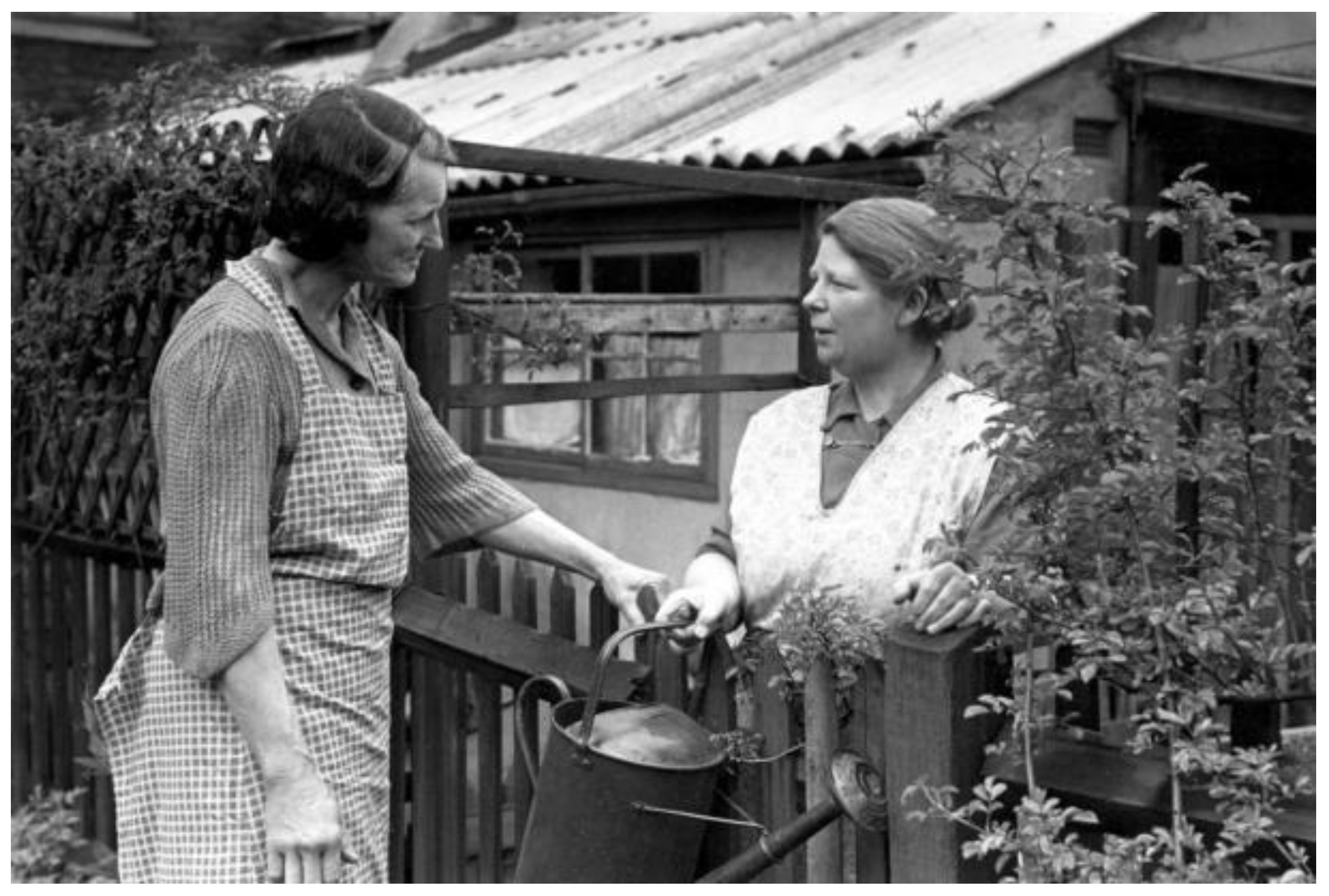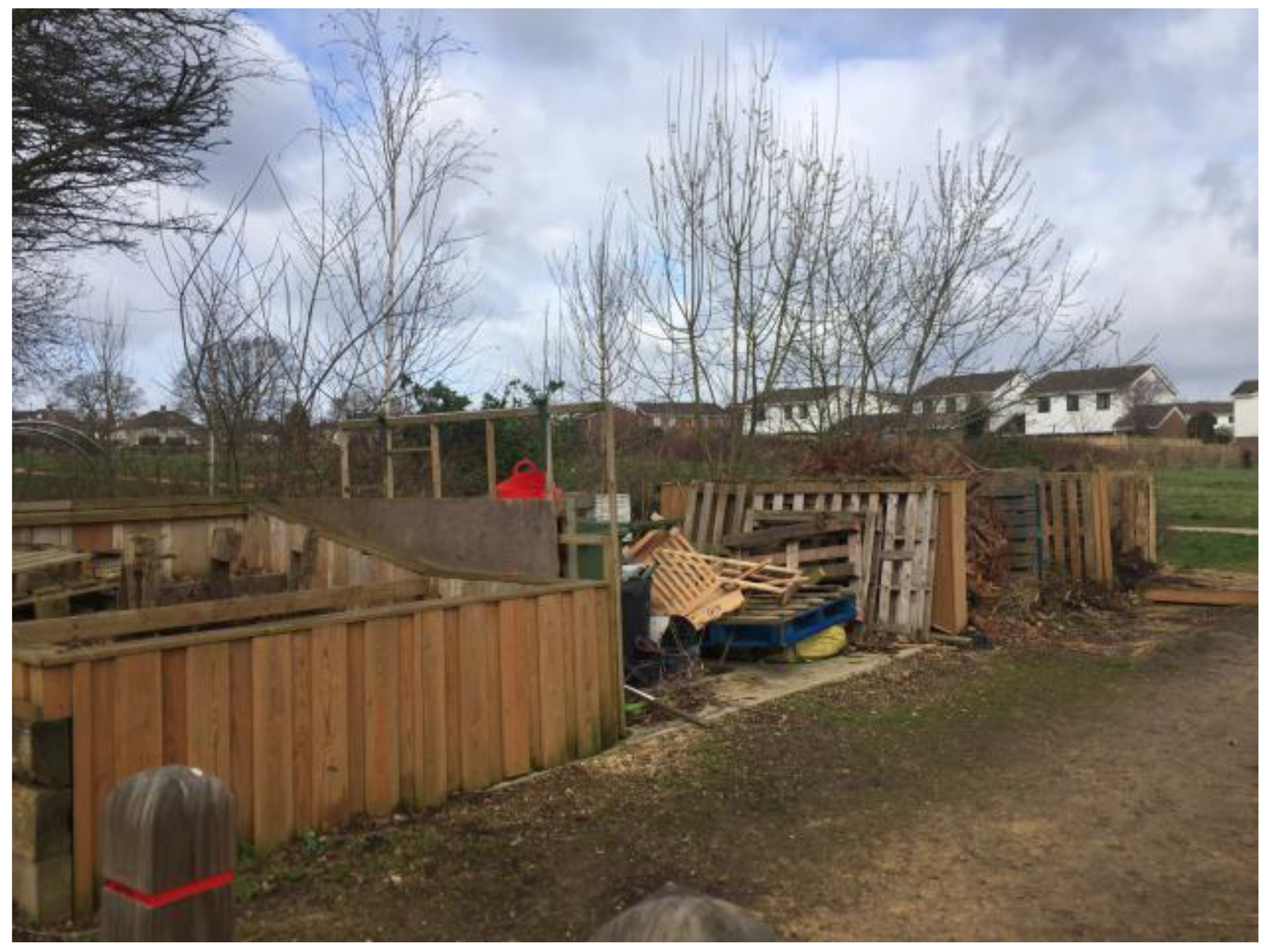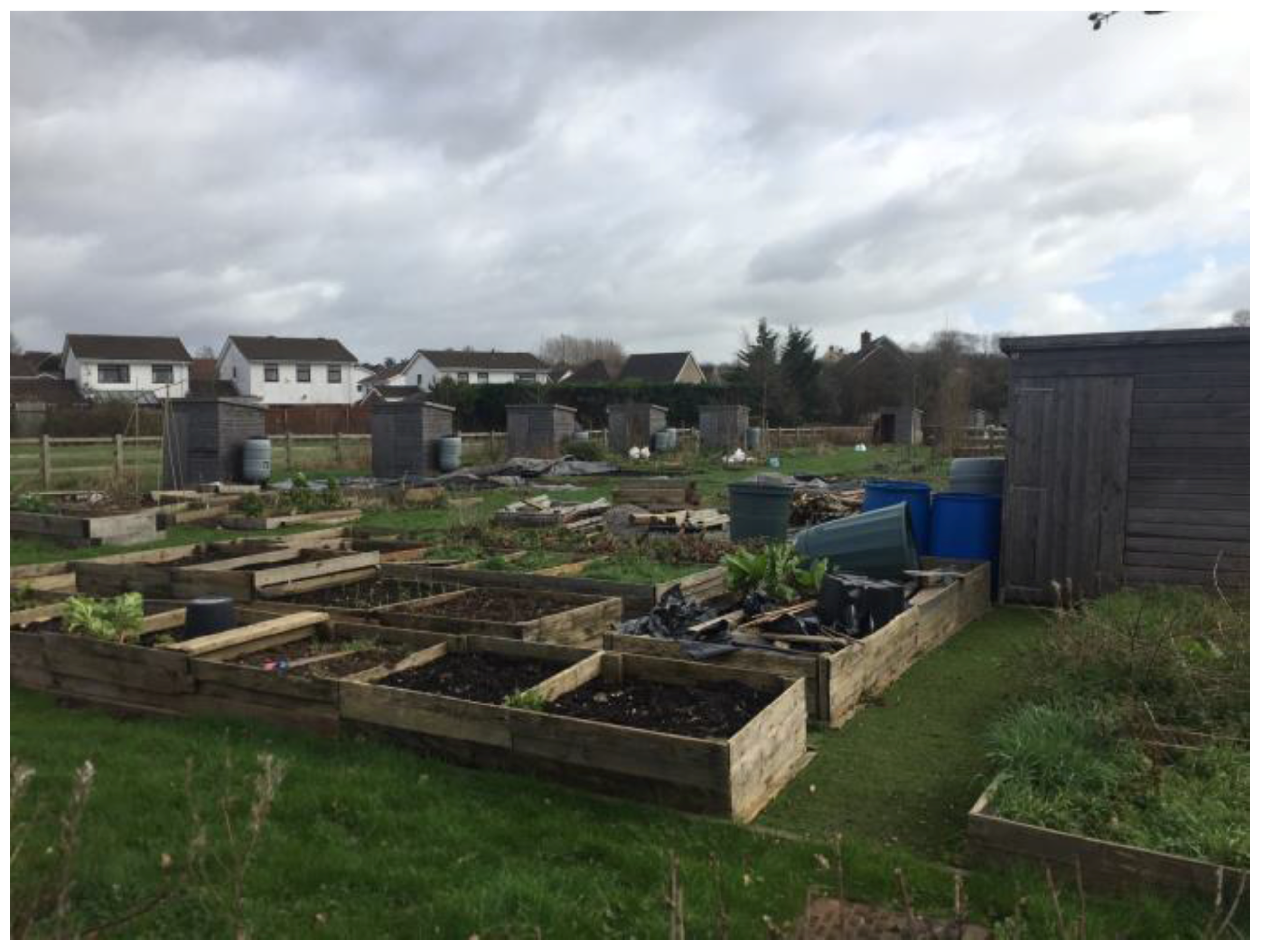Role of ‘Community Spaces’ in Residents’ Adaptation to Energy-Efficient Heating Technologies—Insights from a UK Low-Energy Housing Development
Abstract
:1. Introduction
2. Energy-Efficient Heating Technologies as Constituted through Culture, Spatialities, and Intermediaries
2.1. Resident Behaviour and Interaction with Energy-Efficient Heating Technologies
2.2. The Role of Landscape, Building, and External Informal Spaces
3. Research Methods
3.1. Research Methods—Data Collection and Analysis
3.1.1. Data Collection and Sampling Strategy
3.1.2. Data Analysis
3.1.3. Validity, Reliability, and Generalisability
4. Findings
4.1. Stories of Arrival, Expectations, and Hope
“We moved to the development because we needed to downsize and needed to be frugal with money…obviously it’s reduced bills here…”(Linda and Richard, January 2017)
“Basically, we were living across in Wales in a new development (that was like a) traditional build (being) detached with a garage and on two floors…We used to live nearby, and then moved around a lot; but we had friends here, so it made sense to move back here”…(Simon, February 2017)
“I hadn’t quite realised the impact of living here, as there is quite a lot of drama; sometimes it is like living in the middle of Eastenders with the bailiffs, police, paramedics, fire engines. You can get them all in one night, all outside my own house…”(Dalia, January 2017)
4.2. Learning What a Home Needs–People, Community Spaces, and Places
“I was a little bit of a guinea pig…so they showed me a building and asked me what questions I had, but they didn’t hand over much, apart from a generalistic pack, so I had to find out myself. They also said some things that were utter rubbish; they said don’t ever touch the ventilation system, which is utter rubbish, as you obviously have to change it to summer mode…”(Dalia, January 2017)
“…we didn’t know how to use it. Oh, well, we asked our plumber who services our boiler and he said he didn’t know about thermostats and the such; we thought about the Hive, but really, we don’t need all that, and it wasn’t until Linda and Richard got one and we saw it and thought, “Well, it seems well installed.” Actually, we did call Danfoss (as existing controls are provided by them), but they told us just to use any one? What, from the yellow pages? I wasn’t going to call the yellow pages, was I?(Yvonne, March 2017)
4.3. Managing New Technologies in Home—Escape into the Green
“Initially they (the developers) just wanted your deposit down…bear in mind I’m blonde and I’m artistic…and to live here you need to have mathematical brain…and preferably a partner”…(Jasmine, February 2017)
“…I have like most people struggled with the timer; the boiler; I didn’t get any training…my neighbour has struggled as well; it was too hot; because we have such good glazing, it gets very dry hot…I have a greenhouse as well; I’ve never grown anything, and I thought id just try it…and I love it; it’s pleasant there; its my thing; and you get to know everybody who has a greenhouse; you can wander down there and there are people there; they know what to do with the systems, so you learn…”(Rose, February 2017)
“The outside light and inside light downstairs come on at the same time. Why? We wanted privacy...also it saves energy…and they did it…”(Yvonne, March 2017)
5. Discussion and Conclusions
Author Contributions
Conflicts of Interest
References
- Frerk, M.; MacLean, D. Heat Decarbonisation, Potential Impacts on Social Equity and Fuel Poverty; National Energy Action: London, UK, 2017. [Google Scholar]
- Committee on Climate Change (CCC). Report ‘Next Steps for UK Heat Policy’; CCC: London, UK, 2016. [Google Scholar]
- Department of Energy and Climate Change (DECC). How Heating Controls Affect Domestic Energy Demand: A Rapid Evidence Assessment; HM Government: London, UK, 2014. [Google Scholar]
- Department of Business, Energy and Industrial Strategy (DBEIS). The Future of Heat: Domestic Buildings; HM Government: London, UK, 2016. [Google Scholar]
- Department of Energy and Climate Change (DECC). What People Want from Their Heating Controls: A Qualitative Study; HM Government: London, UK, 2013. [Google Scholar]
- Department of Trade and Industry (DTI). Meeting the Energy Challenge: A White Paper on Energy; HM Government: London, UK, 2007. [Google Scholar]
- Halvorsen, B.; Larsen, B.M.; Wilhite, H.; Winther, T. Revisiting household energy rebound: Perspectives from a multidisciplinary study. Indoor Built Environ. 2016, 25, 1114–1123. [Google Scholar] [CrossRef]
- Gill, Z.M.; Tierney, M.J.; Pegg, I.M.; Allan, N. Low-energy dwellings: The contribution of behaviours to actual performance. Build. Res. Inf. 2010, 38, 491–508. [Google Scholar] [CrossRef]
- Stevenson, F.; Carmona-Andreu, I.; Hancock, M. The usability of control interfaces in low-carbon housing. Arch. Sci. Rev. 2013, 56, 70–82. [Google Scholar] [CrossRef]
- Pitts, A. Passive house and low energy buildings: Barriers and opportunities for future development within UK practice. Sustainability 2017, 9, 272. [Google Scholar] [CrossRef]
- Devine-Wright, P.; Wrapson, W.; Henshaw, V.; Guy, S. Low carbon heating and older adults: Comfort, cosiness and glow. Build. Res. Inf. 2014, 42, 288–299. [Google Scholar] [CrossRef]
- Fennell, C. ‘Project heat’ and sensory politics in redeveloping Chicago public housing. Ethnography 2011, 12, 40–64. [Google Scholar] [CrossRef]
- Lomas, K.; Haines, V.; Beizaee, A. Heating Controls Scoping Review Project; Department of Business, Energy and Industrial Strategy (DBEIS), HM Government: London, UK, 2016. [Google Scholar]
- Oliveira, S.; Prestwood, E.; Chatterton, T.; Poghosyan, A.; Gething, B. Heating Controls: International Evidence Base and Policy Experiences; Department of Business, Energy and Industrial Strategy (DBEIS), HM Government: London, UK, 2017. [Google Scholar]
- Leaman, A. People, Environmental Control and Buildings in Use. Talk held in Reading, UK. 26 January 2006. [Google Scholar]
- Raja, I.A.; Nicol, J.F.; McCartney, K.J.; Humphreys, M.A. Thermal comfort: Use of controls in naturally ventilated buildings. Energy Build. 2001, 33, 235–244. [Google Scholar] [CrossRef]
- Peffer, T.; Pritoni, M.; Meier, A.; Aragon, C.; Perry, D. How people use thermostats in homes: A review. Build. Environ. 2011, 46, 2529–2541. [Google Scholar] [CrossRef]
- Andersen, R.V.; Toftum, J.; Andersen, K.K.; Olesen, B.W. Survey of occupant behavior and control of indoor environment in Danish dwellings. Energy Build. 2009, 1, 11–16. [Google Scholar] [CrossRef]
- Bell, M.; Wingfield, J.; Miles-Shenton, D.; Seavers, J. Low Carbon Housing: Lessons from Elm Tree Mews; Joseph Rowntree Foundation: York, UK, 2010. [Google Scholar]
- Monahan, S.; Gemmell, A. How Occupants Behave and Interact with Their Homes, The Impact on Energy Use, Comfort, Control and Satisfaction; NF 35; NHBC: Amersham, UK, 2011. [Google Scholar]
- Shipworth, M. Motivating Home Energy Action: A Handbook of What Works; Australian Greenhouse Office: Kingston, UK, 2000. [Google Scholar]
- Pett, J.; Guertle, P. User Behaviour in Energy Efficient Homes—Phase 2 Report; Association for the Conservation of Energy: London, UK, 2004. [Google Scholar]
- Stevenson, F.; Rial, H. Paper 595: The Sigma Home Towards an Authentic Evaluation of a Prototype Building. In Proceedings of the PLEA 2008—25th Conference on Passive and Low Energy Architecture, Dublin, Ireland, 22–24 October 2008. [Google Scholar]
- Hellwig, R.T. Perceived control in indoor environments: A conceptual approach. Build. Res. Inf. 2015, 43, 302–315. [Google Scholar] [CrossRef]
- Cupples, J.; Guyatt, V.; Pearce, J. “Put on a jacket, you wuss”: Cultural identities, home heating, and air pollution in Christchurch, New Zealand. Environ. Plan. 2007, 39, 2883–2898. [Google Scholar] [CrossRef]
- Wilhite, H.; Nakagami, H.; Masuda, T.; Yamaga, Y.; Haneda, H. A cross-cultural analysis of household energy use behaviour in Japan and Norway. Energy Policy 1996, 24, 795–803. [Google Scholar] [CrossRef]
- Hards, S. Status, stigma and energy practices in the home. Local Environ. 2013, 18, 438–454. [Google Scholar] [CrossRef]
- Barr, S.; Gilg, A.W.; Ford, N. The household energy gap: Examining the divide between habitual-and purchase-related conservation behaviours. Energy Policy 2005, 33, 1425–1444. [Google Scholar] [CrossRef]
- Mills, B.; Schleich, J. Residential energy-efficient technology adoption, energy conservation, knowledge, and attitudes: An analysis of European countries. Energy Policy 2012, 49, 616–628. [Google Scholar] [CrossRef]
- De Meester, T.; Marique, A.F.; De Herde, A.; Reiter, S. Impacts of occupant behaviours on residential heating consumption for detached houses in a temperate climate in the northern part of Europe. Energy Build. 2013, 57, 313–323. [Google Scholar] [CrossRef]
- Hitchings, R.; Waitt, G.; Roggeveen, K.; Chisholm, C. Winter cold in a summer place: Perceived norms of seasonal adaptation and cultures of home heating in Australia. Energy Res. Soc. Sci. 2015, 8, 162–172. [Google Scholar] [CrossRef]
- Owen, A.; Mitchell, G.; Gouldson, A. Unseen influence—The role of low carbon retrofit advisers and installers in the adoption and use of domestic energy technology. Energy Policy 2014, 73, 169–179. [Google Scholar] [CrossRef]
- Wade, F.; Shipworth, M.; Hitchings, R. Influencing the central heating technologies installed in homes: The role of social capital in supply chain networks. Energy Policy 2016, 95, 52–60. [Google Scholar] [CrossRef]
- Harrison, C.; Popke, J. “Because you got to have heat”: The networked assemblage of energy poverty in eastern North Carolina. Ann. Assoc. Am. Geogr. 2011, 101, 949–961. [Google Scholar] [CrossRef]
- Hitchings, R.; Day, R. How older people relate to the private winter warmth practices of their peers and why we should be interested. Environ. Plan. A 2011, 43, 2452–2467. [Google Scholar] [CrossRef]
- Rupp, R.F.; Vásquez, N.G.; Lamberts, R. A review of human thermal comfort in the built environment. Energy Build. 2015, 105, 178–205. [Google Scholar] [CrossRef]
- Pitts, A.; Saleh, J.B. Potential for energy saving in building transition spaces. Energy Build. 2007, 39, 815–822. [Google Scholar] [CrossRef]
- Cameron, R.W.; Blanuša, T.; Taylor, J.E.; Salisbury, A.; Halstead, A.J.; Henricot, B.; Thompson, K. The domestic garden—Its contribution to urban green infrastructure. Urban For. Urban Green. 2012, 11, 129–137. [Google Scholar] [CrossRef]
- Kurtz, H. Differentiating multiple meanings of garden and community. Urban Geogr. 2001, 22, 656–670. [Google Scholar] [CrossRef]
- Okvat, H.A.; Zautra, A.J. Community gardening: A parsimonious path to individual, community, and environmental resilience. Am. J. Commun. Psychol. 2011, 47, 374–387. [Google Scholar] [CrossRef] [PubMed]
- McMichael, M.; Shipworth, D. The value of social networks in the diffusion of energy-efficiency innovations in UK households. Energy Policy 2013, 53, 159–168. [Google Scholar] [CrossRef]
- Stern, P.C. How can social science research become more influential in energy transitions? Energy Res. Soc. Sci. 2017, 26, 91–95. [Google Scholar] [CrossRef]
- Smith, J.; Butler, R.; Day, R.J.; Goodbody, A.H.; Llewellyn, D.H.; Rohse, M.H.; Whyte, N.M. Gathering around stories: Interdisciplinary experiments in support of energy system transitions. Energy Res. Soc. Sci. 2017, 31, 284–294. [Google Scholar] [CrossRef]
- Blaikie, N. Approaches to Social Enquiry; Polity Press: Cambridge, UK, 2007. [Google Scholar]
- Hodson, M.; Marvin, S. Cities mediating technological transitions: Understanding visions, intermediation and consequences. Technol. Anal. Strateg. Manag. 2009, 21, 515–534. [Google Scholar] [CrossRef]
- Miles, M.B.; Huberman, A.M. Qualitative Data Analysis: An Expanded Sourcebook of New Methods; Sage: Thousand Oaks, CA, USA, 1994. [Google Scholar]
- Silverman, D. Qualitative Research: Theory, Method and Practice; Sage: London, UK, 1997. [Google Scholar]
- Saintier, S. Community energy companies in the UK: A potential model for sustainable development in “local” energy? Sustainability 2017, 9, 1325. [Google Scholar] [CrossRef]
- Mengolini, A.M. Prosumer Behaviour in Emerging Electricity Systems. Ph.D. Thesis, Politecnico di Torino, Torino, Italy, 2017. [Google Scholar]
- Zero Carbon Hub (ZCH). Design as Built Performance End of Term Report; ZCH: London, UK, 2014. [Google Scholar]
- Jalas, M.; Hyysalo, S.; Heiskanen, E.; Lovio, R.; Nissinen, A.; Mattinen, M.; Nissilä, H. Everyday experimentation in energy transition: A practice-theoretical view. J. Clean. Prod. 2017, 169, 77–84. [Google Scholar] [CrossRef]





© 2018 by the authors. Licensee MDPI, Basel, Switzerland. This article is an open access article distributed under the terms and conditions of the Creative Commons Attribution (CC BY) license (http://creativecommons.org/licenses/by/4.0/).
Share and Cite
Oliveira, S.; Marco, E. Role of ‘Community Spaces’ in Residents’ Adaptation to Energy-Efficient Heating Technologies—Insights from a UK Low-Energy Housing Development. Sustainability 2018, 10, 934. https://doi.org/10.3390/su10040934
Oliveira S, Marco E. Role of ‘Community Spaces’ in Residents’ Adaptation to Energy-Efficient Heating Technologies—Insights from a UK Low-Energy Housing Development. Sustainability. 2018; 10(4):934. https://doi.org/10.3390/su10040934
Chicago/Turabian StyleOliveira, Sonja, and Elena Marco. 2018. "Role of ‘Community Spaces’ in Residents’ Adaptation to Energy-Efficient Heating Technologies—Insights from a UK Low-Energy Housing Development" Sustainability 10, no. 4: 934. https://doi.org/10.3390/su10040934



